You Want Beef Eat This Korean Bbq
After almost two decades of eating Korean barbecue at dozens of restaurants and waiting in line for hours on end to satiate that never-ending kbbq craving, I've finally started hosting kbbq at home. This post will give you the best tips and tricks on how to host a fun KBBQ night at home with your friends and family.
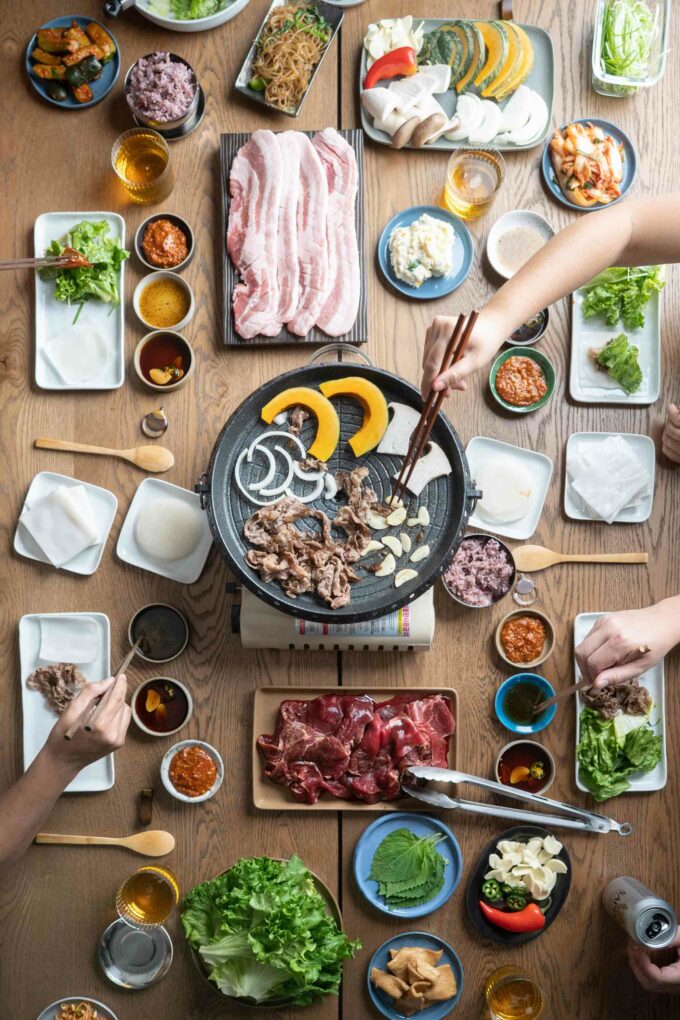
What is Korean BBQ & why you should try it at home
Korean barbecue is one of my favorite ways to share a meal with friends because it's a communal experience. You cook together, share dishes, stories, and drinks–and at the end of the night, you've satiated any grilled meat cravings (you better have!) and had a blast. It's essentially a BBQ party at home.
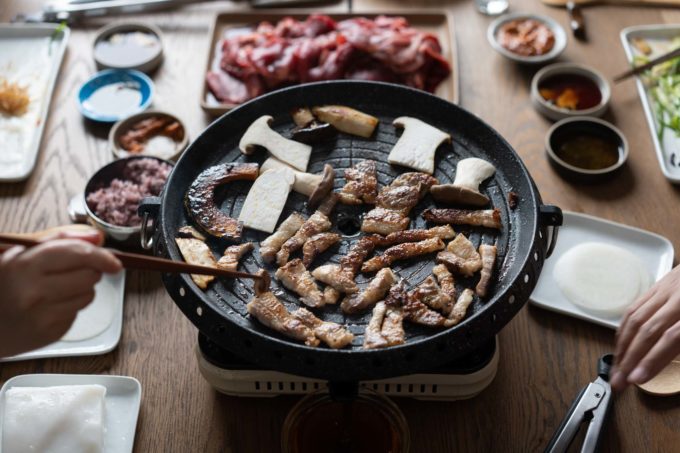
Korean BBQ has been a part of Korean history since the Goguryeo era (37 B.C.–668 A.D.) when skewers were invented that eventually became what we know now as bulgogi. More dishes were added throughout Korea's history, like banchan through Buddhist influence. These days, Korean BBQ consists of multiple parts because there are so many choices and many delicious things to eat. Here's a breakdown of what typically makes up a full Korean BBQ meal:
- Banchan (side dishes)
- Meats and other proteins
- Vegetables and salad
- Wrap options
- Dipping sauces
- Drink options
Different ways to eat Korean BBQ
There is a myriad of ways to eat Korean BBQ. You can wrap your food in lettuce leaves, shiso leaves, rice paper (dduk bossam), and even pickled daikon radish slices.
Lettuce and shiso leaf wraps

This is a more common and traditional way of eating KBBQ.
- Place the wrapper of your choice like a whole lettuce leaf and shiso in your hand.
- Transfer the grilled meat from the grill plate and dip the meat into a sauce. (You can also put the meat on the wrapper and top with the sauce instead of dipping if the sauce is thick like the ssamjang).
- Add any toppings like garlic slices, kimchi, or daikon radish slices. Try not to overfill your wrap so that you can still wrap it up.
- It's the proper way to eat the wrap in one big bite (that's why you shouldn't overfill it) and enjoy.
Dduk bo ssam (rice paper wraps)
This is a somewhat non-traditional way of eating KBBQ and is more common on the West Coast because rice paper was influenced by Vietnamese cuisine. Using rice paper is my favorite way of eating KBBQ.
- Place the rice paper on your plate and layer the daikon slice on top
- Dip the meat into a sauce of your choice and add on top of the daikon slice.
- Add veggies of your choice like garlic, kimchi, and/or salad
- Roll the rice paper over and eat in one bite.
There are different ways to wrap your KBBQ with dduk bo ssam since it's a bit difficult to use with chopsticks due to its slippery texture. Also, the way I eat it can be a little hard to do if you're not used to eating rice paper.
Some people also put salad on their plate, top it with other veggies and meat, and then place the rice paper on top and pinch everything together like an upside-down taco. If you don't like either of these ways to eat KBBQ, you can also simply eat your meat and side dishes with a bowl of white rice or Korean purple rice.
The best grill for Korean BBQ
Ensure air circulation
Before any talk about Korean BBQ at home, you need a WELL VENTILATED space. There are plenty of times I've walked into a restaurant and am just engulfed in smoke because the ventilation was so bad–I'm not sure how that was even legal. No one wants to bathe in plumes of smoke while eating.
The best option is to cook and eat KBBQ outside on a patio or backyard. When I don't have these spaces available, I set up the table nearby a sliding door, open up all the windows in the room and turn on the central fan for air circulation.
The stove

Finding a stove for KBBQ is relatively easy if you have an Asian grocery store nearby.
One of the most straightforward heating appliances to use at home for KBBQ is a portable butane stove. They're widely available at many different Asian grocery stores, are pretty inexpensive, and the gas is already really cheap (and often come in packs of four). We typically use about one to two gas cans per KBBQ session.
Another option for grilling is a small charcoal grill (I use the Weber Go-Anywhere), but it's a bit more complicated since you need to light the charcoal then monitor the coal temps during the entire meal. On top of all that, you have to do the BBQ outside for safety.
You can also use a portable induction stove, however, I feel like these don't get hot enough for the purposes of KBBQ, and you need to buy a grill plate that works on an induction stove.
The grill plate
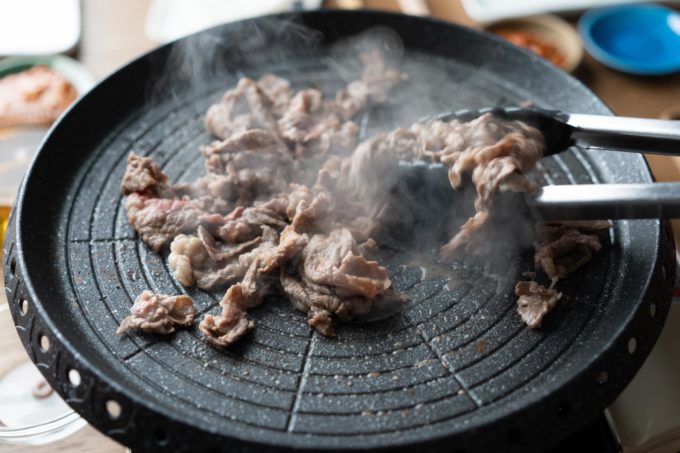
You also need a grill plate to cook all the meat and vegetables. I went on an exhaustive search of where to buy the best grill plate, and luckily we have a lot of Korean grocery stores nearby. I settled on the Hanaro Multi Roaster pan (Amazon alternative). There are varying types of grill plates to purchase, but try to pick one that is round so that the heat is evenly distributed and has a drip tray to catch all the fat.
Tools & Place Setting for KBBQ
Now that you've got your grill and bbq plate, you don't want to forget the tools and table set-up. Easily, these are some things that I often forget because I'm so enamored by the prospects of char-grilled meats, fresh veggies, and myriads of banchan. So before you forget, here's a list of practical tools and props you need to host the best KBBQ at home:

- Tongs, lots of tongs: These things help with cooking meat, serving salad, and other sides to your plate. I like to have at least three pairs of tongs.
- Scissors: These are super helpful for quickly cutting meat like pork belly or veggies when grilling without needing a cutting board.

- Serving plates: These are for vegetables, meats, and other proteins.
- Individual plates: For each guest to make their wraps or eat their salad.
- Spoons and chopsticks: Korean utensils are typically metal (but some people might find these hard to use so it's okay to use wooden utensils too). Korean spoons also are much longer than traditional spoons and we found all these utensils at our local Korean market.
- Rice bowls: If you or your guests like eating rice (especially purple rice), having small bowls is a great option because you use less space on your plate.
- Small plates or bowls: Since there are different banchan (or side dishes), rice paper, and pickled daikon radish to serve on the table, it's great to serve them on small plates that are easy to pass around the table. You can also fit more side dishes on the table if the dishes are small.
- Dipping bowls: Shallow dipping bowls are great for all the sauces
- Glasses and shot glasses
When you set up your table for KBBQ, you want to make the grill the center of attention because you'll be cooking on it and grabbing char-grilled goodies from that spot throughout the night. Arrange all the other plates, dishes, and serving utensils around the grill.
Best types of meat for Korean BBQ

Mmmm, meat, the center of attention of all KBBQ. There are so many different types of options for grilling meat when it comes to KBBQ, but here are some of my favorites:
- Chadol baegi (brisket): Non-marinated, super thin cuts of beef that are one of my favorites. Make sure to buy pieces of meat that are marbled to get a balance. Too lean and it can get tough, and huge chunks of fat can be chewy.
- Bulgogi (thinly sliced marinated pork or beef): marinated beef or pork with a sweet and savory flavor. It comes in thinly sliced pieces that get grilled to tender and seared perfection. Note: you might want to save all marinated pieces for last unless you don't mind cleaning or changing out your grill. The sweet marinade will blacken the grill quickly.
- Galbi (bone-in beef short rib): this beef short rib is also marinated in a similar sauce to bulgogi, but it's a different cut of meat and just as delicious. This is a bone-in cut of meat, so you will need scissors to cut the bones off during the cooking process. Gnawing on the bones is also super satisfying for some peeps.
- Samgyeopsal (pork belly): slightly thick slices of pork belly that are non-marinated, grilled and then sliced into smaller pieces after grilling. This is great paired with grilled kimchi to balance out the fattiness of the pork belly.
- Seafood: shrimp, cuttlefish, and salmon are seafood options if you want something other than beef and pork. These options are great for pescatarians or if you simply want variety. Sometimes H-Mart offers inexpensive deals on salmon strips, and they're great for grilling (or even shabu).
- Other proteins: Other types of protein available are also dak-gui (marinated chicken), (small intestine), (large intestine), and (beef tongue).
How much meat should you buy when hosting Korean BBQ?
The hardest thing about hosting KBBQ at home is guestimating how much meat to buy (as well as other side dishes). I buy about a ½ pound (or 8 ounces) of meat per person. But if I know I'm hosting heavy eaters, I adjust to ¾ to 1 pound per person. So if you're worried about how much meat to buy, just ask your guests how much they typically eat.
Remember, there are also banchan, salads, veggies, and rice paper to eat. I think some of us have eaten so much AYCE (all you can eat) KBBQ that we've lost our ability to gauge volume based on being satisfied vs. forcing ourselves to eat more to make the cost of admission worth it. When you make it at home, it's a much more relaxed environment where you can chill and eat how you please. And no matter how many times we've done KBBQ, we always end up with leftovers.

Vegetables
Not only can you grill meat and other protein, but you can also grill vegetables! Some of my favorite things to grill are onions, winter squash like kabocha, and all the different types of mushrooms your heart desires. I also recommend slicing some garlic and jalapenos to top your wraps.
While some restaurants like to give you sides of lettuce leaves to make wraps, other restaurants have rice paper and sliced pickled daikon radish to make alternative wraps too. With these rice paper wraps, they also give you dressed salad with greens, sliced scallions, and sometimes carrots.
Side dish ideas (banchan)

As if grilled meat, veggies, greens, and rice paper aren't filling enough, no KBBQ meal is complete without banchan (or Korean side dishes). Here are some of our favorite types of banchan:
- Kimchi: spicy, fermented cabbage seasoned with gochugaru (Korean red pepper powder), garlic, fish sauce, sugar, and salt. Sometimes this also has Korean chives, carrots, radish, and other vegetables too.
- Seasoned dried shredded squid (ojingeochae-muchim): dried squid seasoned with gochujang (Korean red pepper paste), garlic, rice syrup, and sesame oil
- Potato salad (gamja-salad): mashed potatoes with carrots, boiled eggs, and cucumbers, then seasoned with mayonnaise, rice syrup, rice wine vinegar, and salt.
- Cubed radish kimchi ( kkakdugi): another version of kimchi made with cubed daikon radish.
- Spinach side dish (sigeumchi-namul): blanched spinach seasoned with sesame oil, garlic, sesame seeds, salt, and pepper.
- Spicy cucumber side dish (oi-muchim): cucumbers seasoned with gochugaru (Korean red pepper powder), onions, garlic, soy sauce, sesame oil, and sesame seeds.
- Kelp noodle salad (cheonsachae salad): cold kelp noodles and sliced carrots seasoned with mayonnaise, rice vinegar, rice syrup, and salt.
While you can certainly make your own banchan and sides, like japchae, chicken-mu, or gamja salad, I prefer buying it at my local Korean markets like H-Mart or Zion to save time. For a group of four, I like to have about four to six banchan options.
Korean BBQ dipping sauces
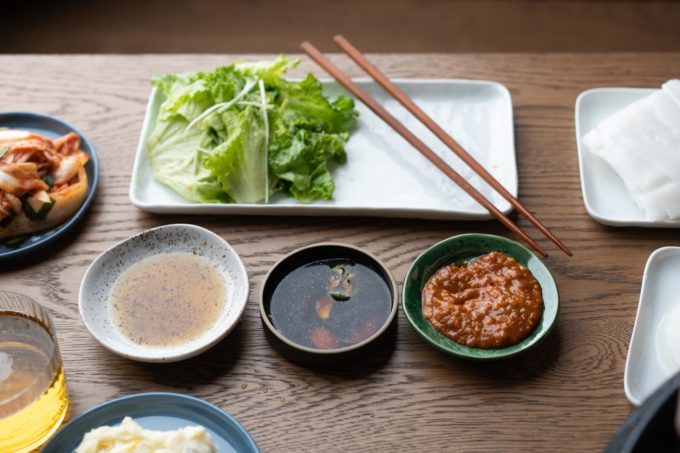
The icing on the cake for each bite of KBBQ is the dipping sauce. There are different types of dipping sauces, but we prefer these three Korean BBQ dipping sauces: samjang, sesame oil and salt, and cho ganjang.
Each restaurant has its own versions, and at home, you can customize each of these based on your seasoning and spice level preferences. To learn how to make these dipping sauces, visit my post here.
Drinks

You can't eat KBBQ without drinks! And drinks are another part of the fun if you ask me. Beer, soju, and soda are standard drinks you can find at KBBQ, and it's just as good at home.
Korean places usually stock a few brands of light lager such as OB, Hite, Cass, and Kloud. My favorite soju flavors are lychee, mango, and green grape. You can find these at your H-Mart or your local Asian grocery store. And if you prefer non-alcoholic drinks of course any sodas or simply iced water is great too.
Where to buy everything you need for Korean BBQ

Make it easy on yourself and find a local Korean grocery store. They have readily available meats that have frozen, marinated, or fresh options for sale and a myriad of freshly made banchan, rice paper, and vegetables. They also have stoves, grill plates, and serving ware available too. Some of my favorite stores are H-Mart, Zion Market, and Airirang.
If you don't have a Korean market nearby, other Asian markets like 99 Ranch and Seafood City should have most of the meat and cooking tools you'd need. For some condiments or specific tools like grill plates, you can fill in with online purchases.
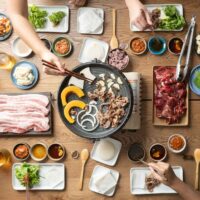
Meat
- 2-3 lb meat, brisket, pork belly, bulgogi, boneless short rib, chicken see above for options
Banchan (sidedishes)
- 4-6 types of banchan see above for options
Vegetables
- 2 heads lettuce
- 1 medium onion sliced
- 1 small kabocha sliced
- 1 package mushrooms sliced
- 1 bulb garlic sliced thinly
- jalapeno sliced
Other
- 32 oz rice paper package or 2 c short-grain rice
Dipping sauces
- 4 servings ssamjang
- 4 servings sesame oil salt dipping sauce
- 4 servings cho ganjang
-
1 small bowl for the drip pan optional if you have a Kbbq plate with a drip
-
4 eating plates
-
1 serving plate for vegetables
-
4-6 small plates for banchan or serve the barchan in the packages they come in
-
1 pair scissors
-
3 stainless steel tongs
-
4 sets chopsticks
-
4 spoons
-
12 small dipping bowls for 3 different sauces
-
4 small rice bowls only if people want rice
-
4 glasses and/or shot glasses
-
A few days before hosting: get a headcount of all your guests and figure out the amount of meat and other food to purchase. Inventory the tools you might need to buy or collect, like a gas stove, grill, Kbbq plate, and other items. You can also use plates and dishes you already have at home. It doesn't need to be fancy.
-
On the day of: purchase all the meat, banchan, other sides, vegetables, rice paper, ingredients for dipping sauce, and drinks at your local Korean grocery store (like H-Mart, Zion Market, Arirang, or others). Note: if you want to marinate your own meat, you will need to start marinating before the day of depending on your recipe.
-
Prepare the sides:
A. Rinse and dry the lettuce and shiso leaves.
B. Rinse the salad leaves and toss the salad RIGHT before serving.
C. Cut the rice paper into 3×3 squares.
E. Cook the rice in the rice cooker.
F. Clean and cut all the vegetables (onion, mushrooms, garlic slices, jalapeno).
G. Make the dipping sauces.
H. Transfer the banchan into dishes (or you can also serve them directly out of their packages).
-
Set the table: place the stove and grill plate in the center of the table. The bigger the table the better–you can fit more items. Set the side dishes, plates of meat, and salad around the grill. Each person should get one plate, one set of chopsticks, one spoon, and dipping bowls for each sauce.

-
Grill the meat: Turn on the stove and begin to grill your meat. Try to grill non-marinated meats first to keep the grill cleaner. Since marinated meats have sugar in their sauce, this will quickly turn the grill black. Turn over the meat once it begins to brown. If you have a drip pan, make sure to monitor the level of fat in the bowl if it needs to be replaced throughout the night.

-
Grill the vegetables: On the edge of the grill plate, leave room to grill vegetables like garlic, onions, mushrooms, and kabocha.

-
While the meat is cooking, eat the banchan and other sides. During the meal make sure to refill any banchan or other sides like rice paper and daikon radish.

-
After the meat is grilled, begin making your wraps using lettuce, shiso, rice paper, and/or daikon slices. Dip the meat in the sauces or add it on top of the wrap, then add other vegetables like roasted garlic, kimchi, or salad. Fold over the wrap with your hands (or chopsticks if you're using rice paper) and take a big bite.

-
Eat the meat and vegetables as soon as they're cooked and enjoy!
Course: Appetizer, Dinner, Lunch, Main Course, Salad, Side Dish
Cuisine: Korean
Keyword: barbecue at home, dinner party, kbbq
Like this recipe? Subscribe to my newsletter!
![]()
Source: https://www.hungryhuy.com/korean-bbq/
0 Response to "You Want Beef Eat This Korean Bbq"
Publicar un comentario